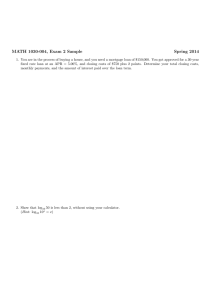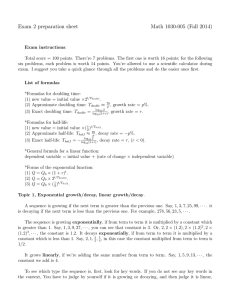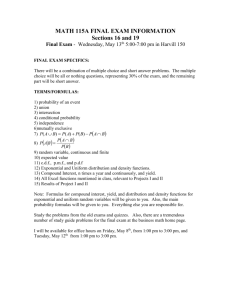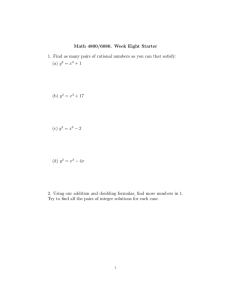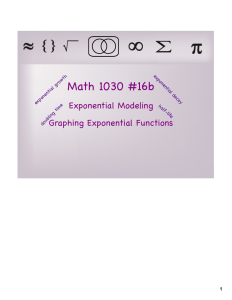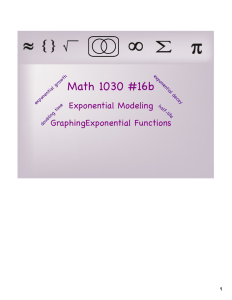Final exam preparation sheet Math 1030-005 (Fall 2014)
advertisement
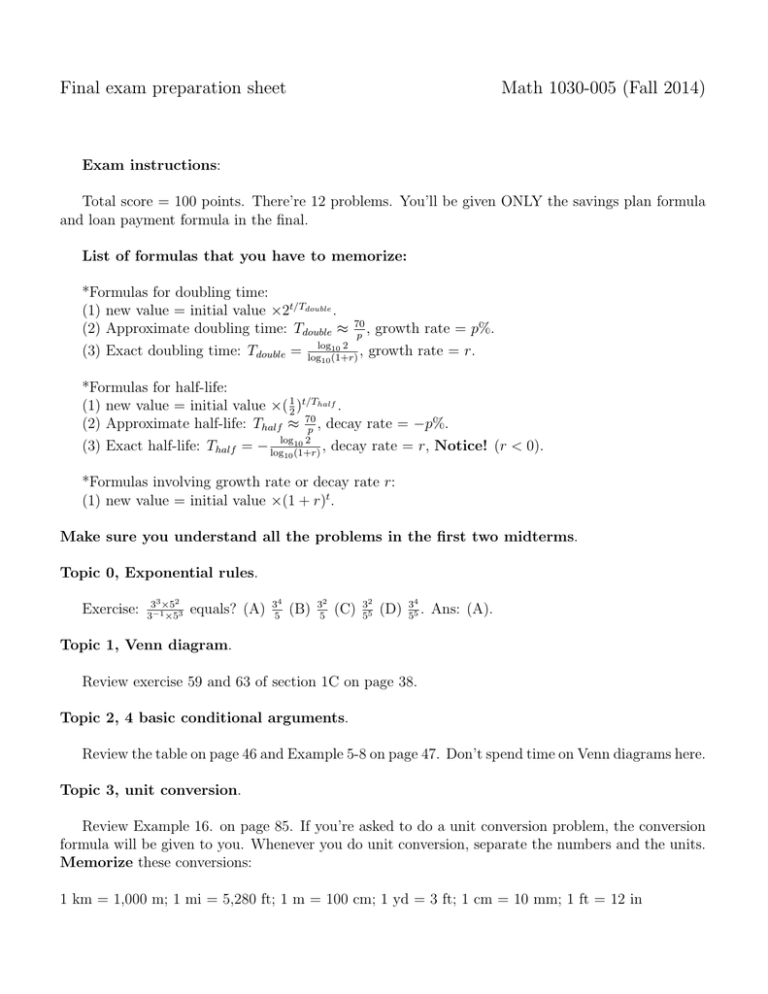
Final exam preparation sheet Math 1030-005 (Fall 2014) Exam instructions: Total score = 100 points. There’re 12 problems. You’ll be given ONLY the savings plan formula and loan payment formula in the final. List of formulas that you have to memorize: *Formulas for doubling time: (1) new value = initial value ×2t/Tdouble . (2) Approximate doubling time: Tdouble ≈ (3) Exact doubling time: Tdouble = 70 , p log10 2 , log10 (1+r) growth rate = p%. growth rate = r. *Formulas for half-life: (1) new value = initial value ×( 12 )t/Thalf . (2) Approximate half-life: Thalf ≈ 70 , decay rate = −p%. p 10 2 (3) Exact half-life: Thalf = − loglog(1+r) , decay rate = r, Notice! (r < 0). 10 *Formulas involving growth rate or decay rate r: (1) new value = initial value ×(1 + r)t . Make sure you understand all the problems in the first two midterms. Topic 0, Exponential rules. Exercise: 33 ×52 3−1 ×53 equals? (A) 34 5 (B) 32 5 (C) 32 55 (D) 34 . 55 Ans: (A). Topic 1, Venn diagram. Review exercise 59 and 63 of section 1C on page 38. Topic 2, 4 basic conditional arguments. Review the table on page 46 and Example 5-8 on page 47. Don’t spend time on Venn diagrams here. Topic 3, unit conversion. Review Example 16. on page 85. If you’re asked to do a unit conversion problem, the conversion formula will be given to you. Whenever you do unit conversion, separate the numbers and the units. Memorize these conversions: 1 km = 1,000 m; 1 mi = 5,280 ft; 1 m = 100 cm; 1 yd = 3 ft; 1 cm = 10 mm; 1 ft = 12 in Topic 4, Absolute / relative difference, absolute / relative change. You have to know what is absolute / relative difference, what is absolute / relative change. “Difference” means to compare two objects, “Change” means we’re keeping track of the change of the same object. Review the formula on page 122, 124 and the problems after those formulas. Topic 5, Scientific notations. Scientific notation means we write a number in the form of a × 10b , where 1 ≤ a < 10, and b is an integer. This expression is unique. Topic 6, Interest formulas. Savings plan formula: A = P M T × R nY ) −1 (1+ AP n AP R n . P M T : the amount of money you deposit into your bank each time; A: accumulated savings plan balance; n: number of payment periods per year; Y : number of years; AP R: annual percentage rate. monthly: n = 12. Yearly: n = 1. Quarterly: n = 4. Loan payment formula: P M T = R P × AP n AP R −nY 1−(1+ n ) . P M T : regular payment amount; P : your total loan; n: number of payment periods per year; Y : loan term in years; AP R: annual percentage rate. In the final you’ll not be told what A, AP R, Y, n, P M T stand for. Loan payment in interest: Review Example 1, page 238. Say, if you use the loan payment formula to get P M T = $200, say this is monthly payment and you pay it for 10 years, then your total payment is $200 × 12 × 10 = $24000. If your principle P is just $20000, then $24000 − $20000 = $4000 is your payment in interest. Topic 7, Solving logarithmic equations. Example 1. Solve 4 = 2x . This one is OK because we know 22 = 4. This shows x = 2. Example 2. Solve 4 = 3x . In this case we have to use the definition for logarithms: x = log3 4. How to evaluate this number? If your calculator can only calculate for log base 10, we have a formula log10 b . (How do you know the log button is log base 10? If you input log(2) and get for it: loga b = log 10 a 0.3010, then it is log base 10.) Example 3. (Slightly complicated) Solve 4 = 2 × 3x . In this case, we divide both sides by 2. Then we get 2 = 3x . It reduces to the previous example: x = log3 2. Example (Hard). In the savings plan formula, given A, AP R, n, P M T , but not Y , how do you calculate for Y ? (Will be explained in the review session) Topic 8, Exponential growth/decay, linear growth/decay. A sequence is growing if the next term is greater than the previous one. Say, 1, 3, 7, 25, 99, · · · . it is decaying if the next term is less than the previous one. For example, 278, 56, 23, 5, · · · . The sequence is growing exponentially, if from term to term it is multiplied by a constant which is greater than 1. Say, 1, 3, 9, 27, · · · , you can see that constant is 3. Or, 2, 2 × (1.2), 2 × (1.2)2 , 2 × (1.2)3 , · · · , the constant is 1.2. It decays exponentially, if from term to term it is multiplied by a constant which is less than 1. Say, 2, 1, 21 , 14 , in this case the constant multiplied from term to term is 1/2. It grows linearly, if we’re adding the same number from term to term. Say, 1, 5, 9, 13, · · · , the constant we add is 4. To see which type the sequence is, first, look for key words. If you do not see any key words in the context, You have to judge by yourself if it is growing or decaying, and then judge it is linear, exponential, or neither. When every time you see expressions like “grows at a rate of 5%”, “decreases at a rate of 5%”, it means it is an exponential sequence. Topic 9, Half-life and doubling time. For an exponential growth sequence, we can calculate the doubling time. For an exponential decay sequence, we may calculate the half-life. If you take a look at all the formulas we have, you can see these formulas require you to know the growth rate or decay rate. It works similarly for calculating the half-life. But notice that the decay rate r you should put in your formula is a negative number. Topic 10, Use half-life or doubling time to predict changes. Use the formulas 1. new value = initial value ×2t/Tdouble or 2. new value = initial value ×( 12 )t/Thalf . Here t is the time difference of the initial value and the new value. Topic 11, Linear equation. Sec 9B, exercise 23, 25, 27. Topic 12, Volume and Surface area of sphere and cylinder. Memorize formulas on page 563. (Table 10.3.) Topic 13, Scaling laws.
